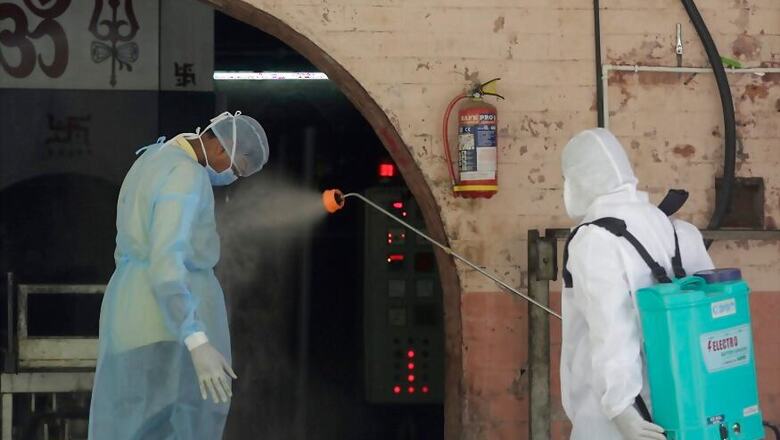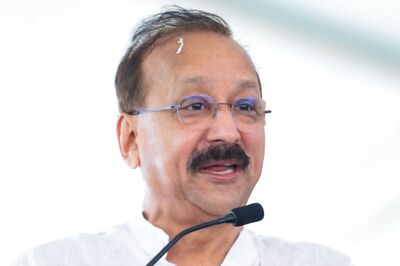
views
More than 350 people have died due to coronavirus in Ahmedabad, the largest city of Gujarat. This has placed the city next only to Mumbai, as far as fatality is concerned. But what makes Ahmedabad sick? Why isn't Covid-19 halting here? These questions are being raised not only in Gujarat now, but in the entire country.
Ahmedabad is wearing a deadly silence these days. Apart from milk and medicine, all other shops are closed, vehicles are off the road. Police force could be seen at every place. The old city area has been handed over to paramilitary forces. This scene is enough to convey that situation in Ahmedabad is deteriorating fast.
The city which heard about coronavirus on March 20 and had its first casualty on March 25, has now seen more than 350 deaths. In the span of 45 days, Ahmedabad has seen 363 deaths till Saturday evening and the total positive cases is touching 5550 mark. If you take the entire state of Gujarat, then the death toll is around 475 and total number of positive cases stand at around 7,800. This means Ahmedabad’s share in total death due to the virus stands at 75%.
The data easily explains the real situation in the city and that's the reason why Ahmedabad wears a deserted look. But till few days ago, the city was not like this.
From morning till evening, vehicles could be seen on roads. At least for three to four hours daily, the lively city didn't make it seem that coronavirus was gripping it fast.
People were seen frequenting streets, sometimes on the pretext of buying vegetables and sometimes to visit a provision store. On Friday evening, when people came to know that there would be complete lockdown in Ahmedabad for next seven days, the kind of crowd that started gathering around 5pm on the streets was not short of a nightmare.
Thousands of people were on the street in every part of the city thronging grocery, fruits and vegetable shops. Long queues could be seen everywhere and this scene continued till late in the night. It did not seem that people were afraid of coronavirus. The increasing cases that forced the city administration to declare complete lockdown came after residents broke all the previous restrictions and did not even adhere to social distancing.
In fact, this has been the tragedy of Ahmedabad. When the virus knocked at the door of the city for the first time some 47 days back, a cursory look at the chronology of the incidents that followed, explains why the situation slipped out of hands there and has turned it into one of the most dreaded cities.
Most of the 70 lakh people of this city, actually never felt that they were facing mortal danger due to the Covid-19 outbreak. They could not imagine that the danger was so huge. When the cases of infection started coming from old city area, people thought it was simply a local issue and it is not going to affect rest of the city. People kept on thronging streets like on any normal day. In the western part of the city, people, especially women, continued to move out of their homes to buy vegetables.
This was one of the reason that it took the infection only three weeks to reach the western part of the city from the eastern part. First, the virus made its way in the old city area, which is also called the 'Walled City'.
Most of the cases were those that were credited to the Tablighi Jamaat. The Old City is a densely populated area, it has narrow lanes with thousands of buildings on each side. It was a real challenge to enforce lockdown in this area. So much so that to keep people indoor, even option of clamping curfew was considered but even this did not deter people.
Whenever curfew was relaxed in Jamalpur, Dariyapur and Kalupur areas of the city, thousands of people got out on the road and the aim of clamping curfew was defeated. The memory of how Congress MLA Imran Khedawala kept on pleading people to remain indoors but it fell on deaf ears. After a few days, Imran himself got infected and had to be admitted to a hospital and now he is back home after getting cured. But another leader of his party, Badruddin Sheikh, was not so lucky. He got infected and was admitted to a hospital but only his body came out.
Seeing the situation slipping out of hands, the administration took the route of cluster quarantine, which means the old city areas were made inaccessible for the people. But even this was not found to be successful. So much so that, BSF and Rapid Action Force had to be deployed in the area. However, this too failed to stop the people.
They kept on moving on the streets and breaking every rule of the lockdown with impunity. The situation worsened during the holy month of Ramzan as large number of people in the old city areas came out on roads in the morning and in the evening.
When all these things were happening in the old city, the western part, across river Sabarmati, was going about with its normal business. The lockdown was there but the whole exercise went in vain with people not adhering to it. The limits were crossed when a lady in city’s Vastrapur area was found making a video in her car to tell the world that despite the lockdown she was able to tour the city with so much of ease. She even shared her video on social media. Police took action but this incident was enough to convey that a large section of the city was not at all bothered about the danger of the virus, while another part of this same city was terribly in the grip of the pandemic.
Now the question is why the administration and police officials allowed these things to happen. The answer is that there was so much confusion at the top that security officials who were supposed to enforce lockdown did not know what to do.
When police was implementing the lockdown strictly and impounding cars, the effect of it was visible on the people and they feared them. But the government realised this soon that if people, who are already troubled due to the pandemic, are disappointed with the government as well, then it would have serious consequences. Both parties in power and those in opposition are eyeing the municipal elections that will be held in all the major and minor cities of the state by the end of the year.
These elections play important role in the state politics. Almost all the political pundits remember that Narendra Modi, who was sent to the BJP from the parent organisation RSS, was instrumental in making BJP victorious in the Ahmedabad Municipal Corporation elections in 1987 for the first time. And after that, BJP has not looked back and in all the Assembly elections after 1995, it has managed to form government in the state on its own.
Probably this was the reason that most of the corporators, in the 48 wards with around 70 lakh people, did not go to the public and insisted them to stay indoors. Instead, they distributed relief material among them and washed their hands off from everything else.
Another major problem was the big gap that existed between the political and administrative wings of the municipal corporation. The corporators thought that municipal officials were not taking them into confidence before taking any big steps regarding the pandemic and this made them stay inactive.
As far as officials of municipal corporations are concerned, they were busy in conducting tests, and increasing number of beds in the hospitals. Large scale testing started in Ahmedabad. But this was not going to be enough for this city. If you are not able to make people agree to stay behind the doors and can’t make them follow the rule of social distancing, there is no question of winning the war against Covid-19 and we know this from the experiences of the other countries.
Meanwhile, another incident happened. The retail traders from the wholesale market in the old city, where the virus first emerged, started frequenting to the western part.
Sabarmati river divides this city into two parts. Jamalpur area of the old city is known for the wholesale market of vegetables, while Kalupur is the wholesale market for grains and spices.
Traders and cart-pullers take their goods from this market to the western side of the river. But this time, while doing so they also carried the deadly virus with them. Municipal corporation is now calling them super spreader.
These are the same retail vegetable and grocery vendors who travel from the old city to new area without any restrictions. One reason was that out of the nine bridges on the Sabartmati river, seven were not closed and traffic was allowed on them.
Now three more bridges have been closed. These vegetable and grocery traders are mainly responsible to spread the coronavirus in the western side of the city and officials of municipal corporation are now banging their own heads and getting them tested on priority basis.
As far as police is concerned, they are entrusted with the task of keeping a watch on retail traders. But in the beginning, they were busy in impounding vehicles and then later were busy in releasing those vehicles because that’s what they were instructed by the political leadership. When it was felt that impounding vehicles will make people angry, they asked police to release them.
The same applies to the efforts of keeping people behind doors. In the beginning, more emphasis was put to keep people away from streets somehow. But when police enforced this, they were told not to do this and even some officials and police constables were suspended for this. The cumulative effect of all these was that police now remained a mute spectator in the whole proceedings.
This affected the morale of police force and when they again went to the people to tell them to remain indoors, they returned infected. Hundreds of police personnel are reportedly infected with the virus. The worst was that when some senior police officers went out to check the deployments on checkpoints and pickets, they did not come out of the vehicles and were seen covered with PPE kits. What kind of message these constables and junior officers were supposed to take, how this could boost their morale is anybody’s guess.
As far as people are concerned, they have done everything to make things worse. In the midst of the lockdown, they kept calling Corona Control Room for gutka, cigarettes, jalebies and rasgulla and kept coming out on the streets on one pretext or the other. The limit of idiosyncrasy was crossed when those who were infected with the virus and were kept in quarantine centres for recovery, were found to be playing cricket in groups rather than sitting isolated in a corner. They used to read newspapers while sitting on plastic chairs outside the room and tried to run away from the hospital when they got the opportunity.
People who were hospitalised for treatment were complaining about the 'tasteless' food. This was the situation in a city where 3,000 beds were arranged in government and private hospitals for possible Covid-19 patients in a matter of a few weeks. People tried to hide the symptoms, they thought it was better not to let anybody know about it lest they will be put into isolation centres for at least two weeks. In such situations, many people reached hospitals with severe infections and died within three-four days after being admitted.
But it did not stop there. People kept going out of Ahmedabad and carried the virus with them. They were even issued passes by the administration to travel to other parts of the state from red zones. It was residents of Ahmedabad who carried the infection to three villages of Banaskantha district. Most of the infections that have spread in other parts of the state, have an Ahmedabad connection. People have been exiting Ahmedabad secretly and have been spreading infections in other parts of the state.
Now the question is what was the state government doing when all these things were going on. Unfortunately, when the virus started spreading its wings in the state, at that time Chief Minister Vijay Rupani called Congress leaders at his residence for a meeting to discuss ways to contain the spread of the virus. These leaders were MLAs from three infected areas of Ahmedabad. One of these was Imran Khedawala, who was found infected a day later.
In that situation, Vijay Rupani got himself quarantined at his residence and could not come out of his house. During this whole period when infection was spreading far and wide, Rupani did not leave his residence. When Chief Minister of Uttar Pradesh – the biggest state of the country — was found everywhere taking stock of the situation, Rupani was only able to use Facebook Live to get his messages across to the public. He conducted meetings with his ministerial colleagues and officials via video conferencing.
Same was the case with the health minister of the state, Nitinbhai Patel, who is the deputy chief minister and number two in the government. Rupani and Patel have never been on the same page from the beginning and everybody knows this. Even during the fight with virus pandemic, the situation did not change much and this affected the strategy of containing the pandemic on the ground level.
The condition in the biggest city of the state kept getting from bad to worse but the state government could not do much other than routine press conferences and FB Live programmes by three to four top officials. A strategy that could stop the situation from getting out of hand and containing the spread of pandemic was missing.
Now the question that arises here is, that when Modi was the chief minister of the state for around 13 and a half years, the state was able to tackle all the big problems and catastrophe in a very effective manner. Then, how was the situation now allowed to slip away, especially in Ahmedabad where country’s best healthcare system is available?
The Civil Hospital of Ahmedabad is famous for its size and medical facilities in the whole country, while SVP Hospital of the municipal corporation is famous for its most modern facilities and which was inaugurated a few years back by PM Modi himself. Those who are keeping a close tab on the administration, say that as a chief minister, Modi used to appoint efficient officials in key positions with clear cut aims and responsibilities and used to monitor their performance personally. He used to give full working freedom to officers but it came with the tag of responsibilities and if they worked well, they were praised and if failed, they were equally punished but he never used to interfere. But unfortunately, in the present dispensation, the goal of officials are not clearly defined neither their responsibilities have been fixed which has created confusion in the ranks from top to bottom and things have been getting bad to worse.
As is obvious, the way situation is taking shape in Ahmedabad, is a source of much frustration for PM Modi. The state which he had left in such a good shape before moving to the Centre, is now the source of his dismay and every little problem that it faces, leaves an impact on him. Be it the grave problem of reservation a few months back or the conditions during the assembly elections of 2017, he had to jump into the ocean to save the ship of the party. Even this time, the situation is the same.
There have been massive administrative overhaul to improve the situation of Ahmedabad. The municipal commissioner of the city, Vijay Nehra has proceeded on two weeks isolation, and Mukesh Kumar has been brought in his place. Before Nehra took over, Mukesh Kumar was the commissioner of the city. To guide him, one of the most senior officers of the state, Rajiv Gupta, who is known for solving any problem with full determination, had also been appointed. It was Gupta who had completed the project of Statue of Unity in record time.
K Kailashnathan, an officer close to Modi is also active now. He is part of the CMO since the time when Modi was the chief minister. Presently, he is the senior-most officer in the CMO and is there with new service conditions despite his retirement. Chief Secretary Anil Mukim and DGP Shivanand Jha have also began cracking whip on junior officers. Everybody knows that in PM’s home state, and that too in its biggest city Ahmedabad, worsening of the situation is neither in the interest of the people nor it creates better image of the state government. Even AIIMS director Dr Randeep Guleria has been sent from Delhi to assess the situation in Ahmedabad and formulate the strategy to tackle the situation. Veteran medical administrator of the state, Dr MM Prabhakar has also been asked to oversee the functioning of the civil hospital once again.
So this hardening of the stance was essential and this has been set in motion now. Even the people of Ahmedabad must have started to feel the change and it is expected of them that instead of enjoying the lockdown, they must take precautions. Besides self-control, Gujarat police and paramilitary forces have also been deployed to change the face of the city. Let us wish all the best to India’s only UNESCO designated world heritage city to get well soon!

















Comments
0 comment